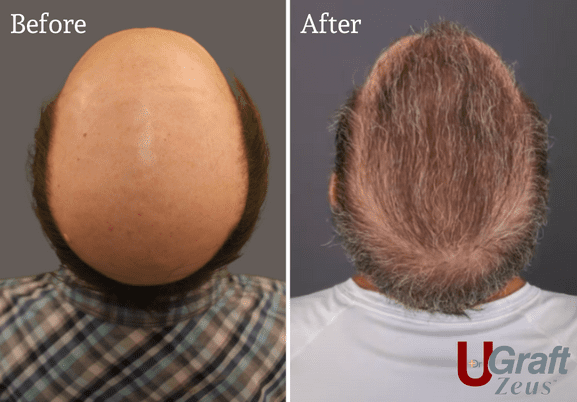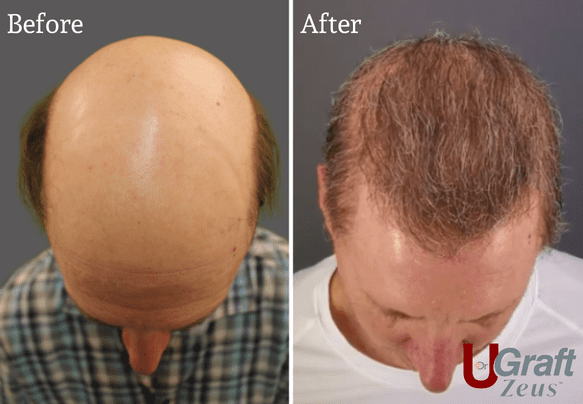What’s FUE?
Follicular unit extraction (FUE) is a type of hair transplant surgery where the surgeon uses an FUE device to excise hair grafts from the head or another part of the body and then implants those grafts in the part of the head where hair is thinning.
Limitations of Previous FUE Technologies
While FUE is currently the most minimally invasive and reasonably well-established long-term solution to hair loss, it’s unfortunately not suited for all hair loss patients. A significant challenge in the procedure is the lack of a single device that can adequately meet the requirements of a range of patient donor variables, including hair curliness, skin thickness, donor area (head or non-head), body hair FUE, and non-shaven long hair. This means a considerable number of individuals suffering from hair loss and looking to get a hair transplant are deemed poor candidates for FUE. To address this problem, a novel FUE device was developed based on skin responsiveness to serve as a single all-purpose FUE donor harvester.
How Do Those Limitations Affect Certain Demographics?
The limitations of conventional FUE often translate into patients of specific racial and ethnic backgrounds being turned down by FUE practitioners. The classic Punch is unsuitable for harvesting follicles of certain angling and attachment types. It shouldn’t come as a surprise that the population affected the most by this exclusion are people with curly afro-textured hair.
A surgical procedure cannot be touted as the best method of hair transplantation if 20% of the world’s population is not serviceable by it. Ironically, men of African descent are more likely than any other demographic to prefer shaving their heads. This means they, more than any group, need the FUE method of hair transplantation, which enables a close shaving of the head because it creates less visible scarring compared with the other methods of hair transplantation (Follicular unit strip surgery, which creates linear scars that the operator must struggle to hide or the rest of their lives. Hair loss is a problem that affects everyone, and it’s reasonable to expect clinical solutions to be available for anyone suffering from the condition.
What if Someone Does Not Have Enough Hair On Their Head?
Another universal limitation of the classic FUE device punch is the donor area. Since hair grows differently on different body areas than on the head, a punch that works fine when harvesting grafts from the scalp doesn’t do the same in other donor areas. Now very bald people with hair loss levels 6 and 7 have lost about 50,000 follicles get that bald. However, the lifetime head donor supply (from the back and sides of the head) is only 7000 – 8000 follicles. This means such an individual will never have enough head donor supply to credibly restore his areas of level 6 or 7 baldness. Suppose the person has a lot of beard and body hair supply. In that case, however, grafts from those areas can expand the donor pool and make it possible to execute a credible-looking hair restoration result.
The inability of basic FUE devices to extract any and all body hair is thus a limitation that excludes severely bald individuals from attaining credible restoration. It effectively takes the procedure out of the reach of very bald individuals.
The Ugraft Zeus
The Ugraft Zeus is the first all-purpose FUE device in the world and has undeniable advantages over the classic FUE device. It comes with what world-renowned hair expert Dr. Sanusi Umar has named the Intelligent Punch, which has several patented and patent-pending attributes, marking a major paradigm shift in FUE punch design. The Punch, manufactured by Dr. U Devices Inc of Manhattan Beach, CA, is a specialized punch designed to address the technical challenges of Follicular Unit Extraction (FUE). With its ability to compensate for punch misalignment, eliminate torsion injury while the graft is inside of the lumen, and the intuitive navigation of deep skin course regardless of angulation or texture, the Punch incorporates design solutions to ensure that hair grafts are not lost or rendered nonviable by transections, crush injuries, and complete de-sheathing. It also solves the issue of poor scarring profiles through its novel design.
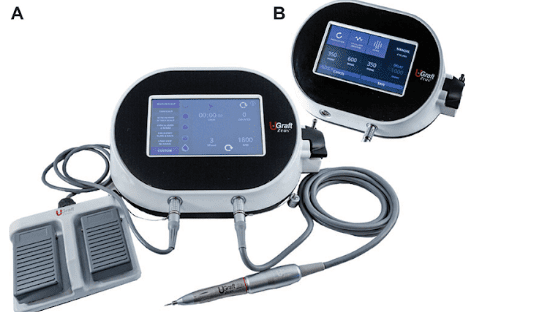
Design Improvements Over the Traditional Device
The Dr.UGraft Zeus Console has an integrated fluid hydration system and torque, speed, and multiphasic movement mode settings. The UGraft Zeus ergonomic rotary handpiece connects the Intelligent Punch to the Console.
The Intelligent Punch
The Dr.UPunch incorporates several unique design features that address the various factors contributing to poor graft take rates and suboptimal results in traditional FUE procedures. For this reason, it is justifiably called The Intelligent Punch.
PATENTED FLARING:
The blade of the Intelligent Puch flares out, unlike the traditional blade that is straight. The flared design allows for minimal collateral damage during the cutting process without bringing up the risk of damaging hair grafts being harvested in the process. This is because adding flaring ensures the edges of the blade point away from the hair graft, thus minimizing the rate of transections.
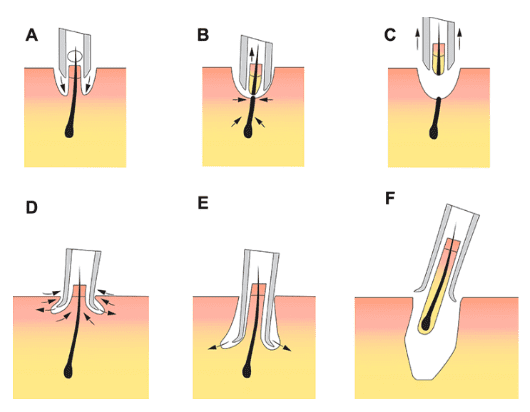
Possibly the two biggest factors that contribute to higher transection rate, are curly and coily hair, and misalignment of the Punch. For this reason, individuals with curly and coily hair types are often considered challenging FUE patients and often turned away by doctors. When patients with curly or coily hair undergo an FUE surgery, the deeper the blade goes in, the higher the chances of the hair graft getting cut off by it. Flaring out the edges of the blade allows FUE surgeons to go deeper without the risk of injuring or completely cutting off the grafts. The flared design compensates for mild to moderate punch misalignment and, thus, drops the rate of transections. In addition, the deeper the blade goes in, the bulkier the grafts are, which means more cushioning and protection for the graft leading to a higher chance of survival.
PATENTED TEXTURING:
Another feature of the Intelligent Punch is its patented texturing. The textured design allows for a more intuitive minimal-assist navigation (MAN).
The Zeus does not use a suction device for its functions. The elimination of suction minimizes the sterilization requirements from suctioning bodily tissues and fluids into the device.
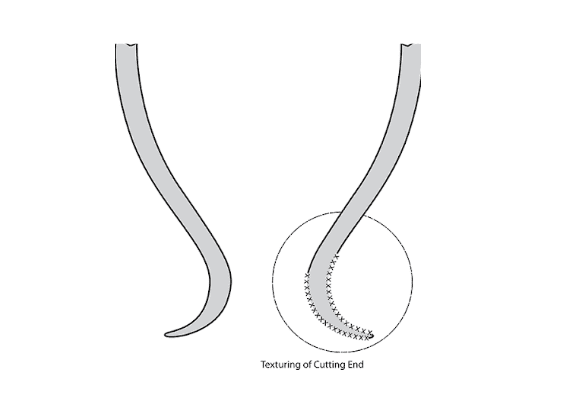
PATENT PENDING CONICAL DESIGN:
Traditionally, FUE punches have a cylindrical design. The Ugraft Zeus changes this up with its patent-pending frustoconical design. The result is less graft attrition from friction and an intuitive slowing of Punch with increasing depth. It also aids in separating the graft from its attachments by blunt rather than sharp dissection—all these add to less graft damage and more intuitiveness.
WOUND HEALING ADVANTAGE:
The Intelligent Punch is designed to create wound shapes that impart a healing advantage when compared with wounds created by other FUE device punches of the same size. The relatively less-everted wound edges it creates close better than the more everted wounds created by other punches resulting in less visible scarring. This is demonstrated in the following video:
No Title
No Description
Skin-Responsive Punch Driver
OVERVIEW:
With the feedback it receives from the Punch, the operator can adjust the U-force to an appropriate level for the resistance posed by the skin. The main factors in this intuitive mechanism are the speed and torque of the driver, which in turn are influenced by the firmness and thickness of the skin.
This allows the UGraft Zeus to be capable of all skin and hair scenarios. In the following video, the UGraft Zeus and its intelligent Punch are seen to be penetrating the chest skin deliberately and purposely, unfazed by the twisting of the skin:
Chest Hair Excision for an FUE Hair Transplant Surgery
Dr. Umar Hair & Skin Clinic located in Manhattan Beach, CA -Visit our website: https://dru.com/ -Free Online Consultation (viewed within 24 hours by Dr. Umar): https://dru.com/free-consultation/ **Follow us on social media** -FB: https://www.facebook.com/Doctorsanusiumar/ -IG: https://www.instagram.com/drsanusiumar/ -Twitter: https://twitter.com/drsanusiumar -Pinterest: https://www.pinterest.com/drsanusiumar/
USER-FRIENDLY PRESETS:
The UGraft Zeus has different presets based on skin thickness, hair type, and donor area to make things even easier. It also includes a preset for deriving long hair shafted follicles in a long hair FUE procedure. To use the presets, all the operator does is press a preset button for the specific FUE donor scenario they encounter. The system then does the rest. It will adjust the U-force, speed, 3 movement types, orders, and duration needed to perform the procedure optimally, as well as the speed of the movement if adjustments are necessary.
MULTIMODAL or MULTIPHASIC, or COMPOUND MOVEMENT CAPABILITY:
As the Punch penetrates and scores the skin around the graft, it faces different challenges along the length of the graft – beginning from the skin surface around it to the depth of the follicle that extends just below the bulb located in the subcutaneous layer in most instances. On the skin surface, it has to overcome the resistance of the epidermal surface lining. In the dermis, it is the thick collagen around the follicle that must be breached. Curly hairs assume a bent course at an angle in the dermis. It is at this point of bending that the graft is susceptible to transections if the Punch and device are not sophisticated enough to navigate through it. Next, the Punch must shake off the loose but tenacious elastic fiber investing the follicle and attaching it to the subcutaneous layer.
On the other hand, in the two basic punch movements known as rotation and oscillation, the former is faster but results in more transection, while the latter is slower but produces less graft damage.
A compound moving punch device (Zeus) uses both rotational and oscillatory movements in the course of excising each graft, taking advantage of their benefits. In the top area, where there is less chance of transection, rotation is favored, but in the deep dermis, where the hair is susceptible to damage owing to its curved course and the dermis and erector pillar muscles are holding on tightly, oscillatory movement is favored.
The UGraft system also allows the operator to set the duration of each movement phase.
The myriad of innovations in both the punch driver and the Punch of the Zeus system creates a system that is capable in all FUE scenarios, including but not limited to all curly FUE and long hair FUE.
Zeus Long Hair FUE
For decades, unshaven FUE, also known as long hair FUE, is an FUE procedure that is performed:
- Without shaving or cutting the donor short.
- To derive short or long grafts.
Previous devices have accomplished this task by adding a slit or indent on their punches. The hair slides into the gap to protect it from being cut; the Punch is then driven into the skin as in regular FUE. However, in the Zeus, with its intelligent Punch working off a completely different FUE paradigm, the same Punch, which has no groove or indent, performs long hair better and more efficiently.
How does it achieve this feat? Well, all the discussed patent and patent-pending features adopted in the intelligent Punch and the Zeus driver design are what make it so. Not only is it efficient at long hair FUE, but its MAN effect and overcoming of issues of punch misalignment also makes it especially useful in long hair fue performance since, in long hair FUE, the operator does not have the visual cues used to gauge the hair’s angulation. Since Zeus intuitively navigates angulation, all the operator needs to do is always hold the Punch at 90 degrees angle to the scalp surface. Furthermore, since the operator does not struggle to fit the hairs into the slits or indents, the procedure is faster and more efficient.
How To Perform Long Hair FUE. Non Shave FUE Made Easy – Zeus
How To Perform Long Hair FUE. Non Shave FUE Made Easy Using the UGraft Zeus
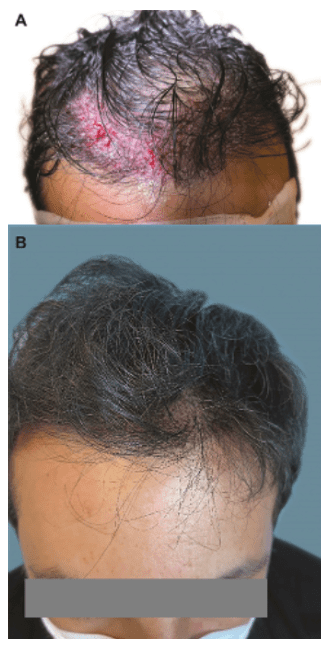
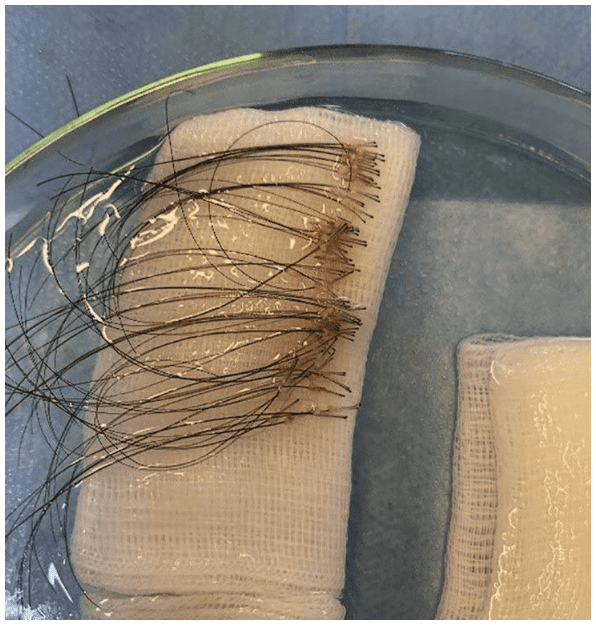
Larger Donor Area Pool Makes FUE Accessible to More Patients
Since the Ugraft Zeus makes adjustments based on skin thickness and hair curliness and compensates for potential punch misalignment, the device makes it possible to utilize body hair as donor areas, giving patients several advantages. Body Hair Transplant (BHT) allows surgeons to safely use donor hairs from the beard, chest, stomach, arms, legs, and nape, as well as other body areas, for hair extraction. This vastly expands the donor pool and makes FUE hair surgery much more attainable for patients previously deemed unfit for an FUE operation. Another overlooked advantage of using non-head donor areas for transplants is a much larger array of hair textures and thicknesses all over the body. A trained professional should be able to take advantage of that, as using hair grafts of different thicknesses yields a lot more natural-looking results on the head.
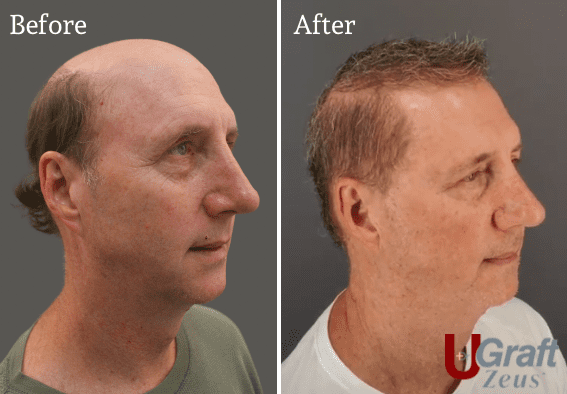
A New Day for FUE Patients with Afro-Textured Hair
FUE on Afro hair has always been considered challenging. In fact, many patients of African descent are often turned away from clinics because of that. FUE doctors who accept those patients often report high attrition rates despite their best efforts. Previously, FUE operators would record as high as 50-60% graft damage rate in some Afro-textured-haired patients using traditional FUE devices. The same doctors now report a drastic fall in the graft damage rate in these same patients, with transections falling from 50-60% to 5-10% due to using the Zeus.
Many individuals of African descent suffer from traction alopecia on top of androgenic and scarring alopecia, which is huge in the hair transplant industry. The invention of the Ugraft Zeus is the first step in ensuring consistently good results for all FUE patients. The next logical step is making UGraft Advanced FUE more accessible to patients worldwide by distributing the Ugraft Zeus to FUE surgeons.
Accurate Patient Evaluation and Safer Measures to Provide Better Results
In his many years of practice, the inventor of the UGraft, Dr. Umar, observed that his graft attrition rates would change when he switched areas on the same patient. Despite the hair curl pattern staying the same from area to area, the attrition rate change was significant enough for Dr. Umar to realize the need for a study to understand better the main factors determining FUE procedure difficulty levels. His studies did, in fact, show that skin plays a much more significant role in FUE difficulty level than hair pattern does.
New FUE Classification System Explained. Know Your Hair Transplant Donor Type To Predict FUE Outcome
Dr. Sanusi Umar AKA Dr. U talks about his findings regarding FUE challenges. He discusses the myth of curly hair FUE being the most difficult and talks about the real factors that make an FUE operation more or less challenging.
Dr. Umar has developed a new FUE patient classification system that helps FUE practitioners better evaluate their patients. The scoring system is based on hair curliness and skin thickness. When evaluated with the new classification system, which is called Sanusi FUE Score Scale (SFS Scale), patients are categorized into five classes of FUE difficulty levels. In the classification system, Class V denotes the most challenging FUE patients. FUE procedures on patients identified as Class I and II present no to low difficulty. Class III to V patients range between moderate to high FUE difficulty.
While conventional FUE may work fine for Class I and II patients, it’s not advanced enough to excise grafts from Class III-V patients without transection rates rising significantly. For class III and IV patients, an advanced FUE device, like the UGraft Zeus, is necessary, even more so for Class V patients. As FUE is supposed to be a permanent solution to hair loss and is costly, it is of utmost importance that surgeons are adequately equipped to provide reliable results to all FUE patients. The Ugraft Zeus enables doctors to achieve consistently low damaged graft rates for all patients, including Class III-V.
FUE Practitioners and Patients Alike Would Benefit From The Ugraft Zeus
With its many apparent upgrades over the classic design, the Ugraft Zeus should become the standard device used for FUE procedures. It is in the interest of everyone involved – the device would make the procedure more accessible for patients. It would yield more consistently good results, all the while making the learning curve smaller and operating the device easier for FUE surgeons.
References
- Mohmand MH, Ahmad M. Transection rate at different areas of scalp during follicular unit extraction/excision (FUE). J Cosmet Dermatol. 2020;19(7):1705-1708. doi:10.1111/jocd.13191
- Rogers NE, Callender VD. Advances and challenges in hair restoration of curly Afrocentric hair. Dermatol Clin. 2014;32(2):163-171. doi:10.1016/j.det.2013.12.004
- Singh MK, Avram MR. Technical considerations for follicular unit extraction in African-American hair. Dermatol Surg. 2013;39(8):1282-1284. doi:10.1111/dsu.12229
- Umar S. Body Hair Transplant by Follicular Unit Extraction: My Experience With 122 Patients. Aesthet Surg J. 2016;36(10):1101-1110. doi:10.1093/asj/sjw089
- Umar, S., Lohlun, B., Oguzoglu, T., & Carter, M. (2021). A Novel Follicular Unit Excision Device for All-Purpose Hair Graft Harvesting. Clinical, Cosmetic And Investigational Dermatology, Volume 14, 1657-1674.
- Umar S, Shitabata P, Rose P, et al. A New Universal Follicular Unit Excision Classification System for Hair Transplantation Difficulty and Patient Outcome. Clin Cosmet Investig Dermatol. 2022;15:1133-1147. Published 2022 Jun 27. doi:10.2147/CCID.S369346
- Umar S. Use of nape and peri-auricular hair by follicular unit extraction to create soft hairlines and temples: my experience with 128 patients. Aesthet Surg J. 2015;35(8):903-909. doi:10.1093/asj/sjv137

